When I think about summer desserts, this homemade chilled Fruit Jelly is always the first thing that pops into my mind. It’s colorful, refreshing, and light. Perfect to make use of the seasonal fruits!
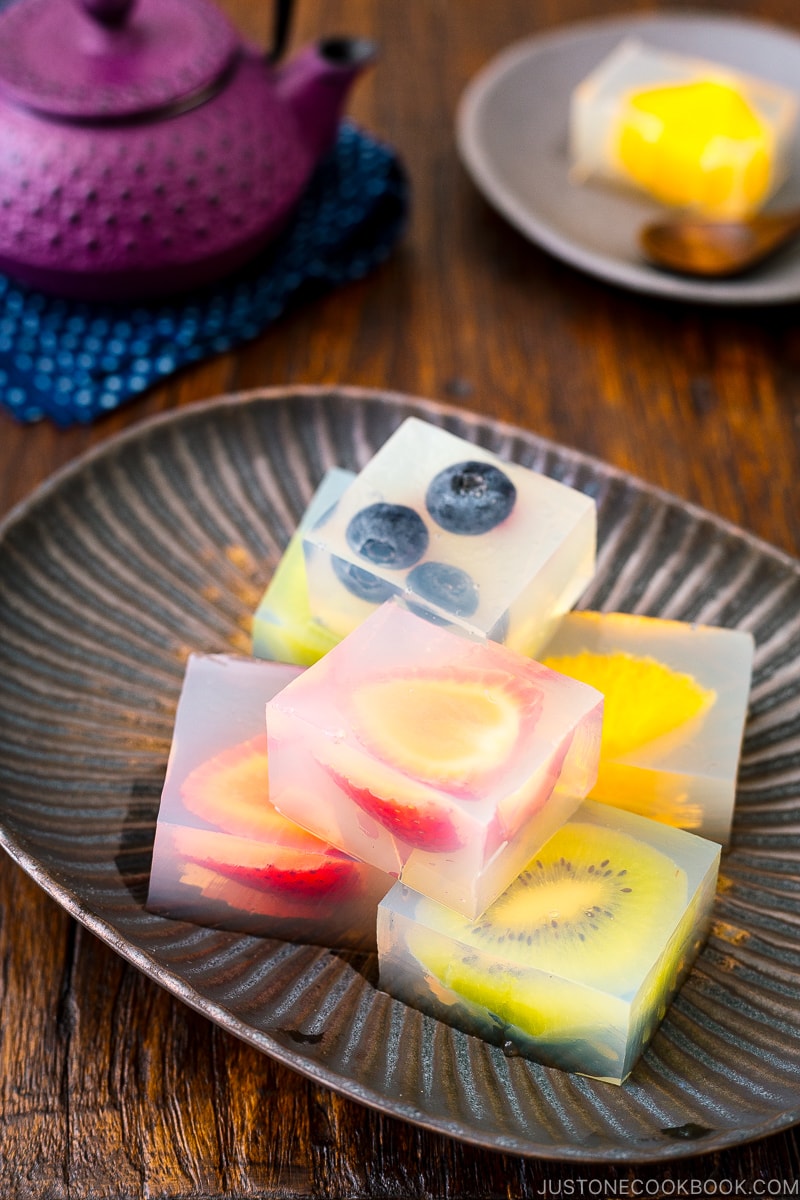
What are your favorite sweets to enjoy and cool down on hot summer days? One of my favorites is this translucent fruit jelly. The see-through jelly reminds me of ice cubes and makes me feel cool instantly as I imagine the chilled jelly with refreshing fruits in my mouth.
This quick and easy dessert recipe has been in my mind to share for quite a while, and now is a perfect time as I am still kitchen-less. Based on the latest estimate, I might have a functional kitchen in 2 weeks… I just can’t wait.
Easy Fruit Jelly Recipe
It’s super easy to make this attractive dessert. All you need is a portable stove, a small saucepan, a cutting board, a knife, and a mold. If you are wondering how I created this recipe, it was created in my upstairs office, now a kitchen/dining room.
Making it homemade means it won’t contain artificial flavors, colors, or additives. Plus, it’s dairy and gluten-free.

Ingredients and Equipment for Fruit Jelly
1. Kanten

This jelly is made with kanten powder. In case you’re unfamiliar, kanten (寒天) is a white and semi-translucent gelatinous substance obtained from algae. Just like gelatin, it solidifies liquid.
However, kanten is vegetarian and vegan-friendly, a great alternative to animal or chemical-based gelatin.
2. Nagashikan – A Mold with a Removable Inner Tray
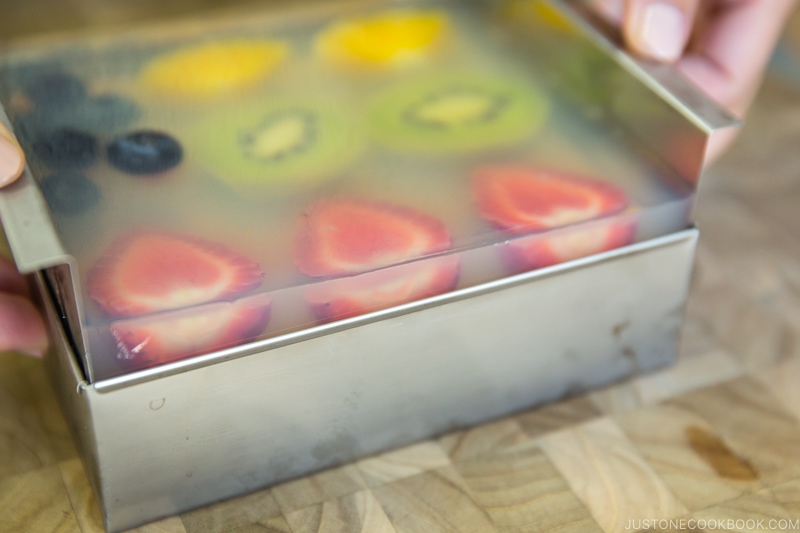
I bought a traditional Japanese stainless steel mold with a removable inner tray called Nagashikan (流し缶) for this recipe. This removable inner tray makes it easy to un-mold the food if it easily sticks to the container.
We use it to make Tamago Tofu (玉子豆腐) and traditional cold treats like Yokan (羊羹, azuki bean jelly).
But no worries, if you don’t have this, you can simply use a mold or baking pan with a higher rim and place plastic wrap on the bottom so you can un-mold easily. You can purchase the mold from Amazon (this is the bigger size) or Rakuten.
Another option is to cut all the fruits into small cubes and serve this dessert in individual glass cups. I usually make my fruit jelly that way, and it looks pretty in a glass container.
If you serve this jelly in individual cups, reduce the kanten powder to 2 grams. That way, the jelly is softer and jiggly. Today’s recipe requires us to cut around the fruits, so the jelly is designed to set firmer, and it won’t jiggle as much. More explanation on this is in the next section.

Helpful Tips to Make Fruit Jelly
1. The texture of the jelly
If you prefer softer jelly textures that are not firm, like my fruit jelly today, you can reduce the amount of kanten powder to 2 grams (half the package).
If you do so, I highly recommend chopping fruits into smaller cubes, making the jelly in individual cups or a large baking pan, and serving with a spoon.
Less kanten powder will result in jelly that would jiggle (プルプルって感じ), and it will go through your throat smoothly. If you prefer to make this “ice cube” style, keep the ratio as it is.
2. Choice of fruits
Besides the fruits I used for this recipe, you can use cherries, apples, grapes, and peaches. Canned mandarin oranges and peaches are excellent choices, as the syrup adds sweetness. I recommend an assortment of colorful fruits that would look pretty suspended in jelly.
3. Amount of sugar
This recipe uses 4 Tbsp. (1/4 cup) of sugar. To call this dish “dessert,” this amount is necessary.
If you want to omit sugar or use less, the fruits you use must be super sweet or canned in syrup. So, 4 Tbsp. for healthier jelly, and 6-8 Tbsp. for “dessert” fruit jelly. Please adjust the sugar amount to your liking.
4. Kanten powder
There are three types of kanten (powder, stick, and thread), and you can use any one of them. I used kanten powder for this recipe.
Kanten can be found in your local Japanese (or Asian) grocery stores, and you can also purchase it online at Mitsuwa or Marukai (for US residents).
For conversion from 2 tsp (4 g) kanten powder, you will need:
- Kanten stick = 1 stick (8 g)
- Kanten thread = 24 threads (8 g)
If you want to use agar or gelatin instead, you will need 4 tsp of agar or powdered gelatin (8 g). Please remember the jelly made with gelatin will quickly melt in the summertime while kanten will not melt at room temperature (read more here).
If you have any questions about kanten, read this post first.

Wish to learn more about Japanese cooking? Sign up for our free newsletter to receive cooking tips & recipe updates! And stay in touch with me on Facebook, Pinterest, YouTube, and Instagram.
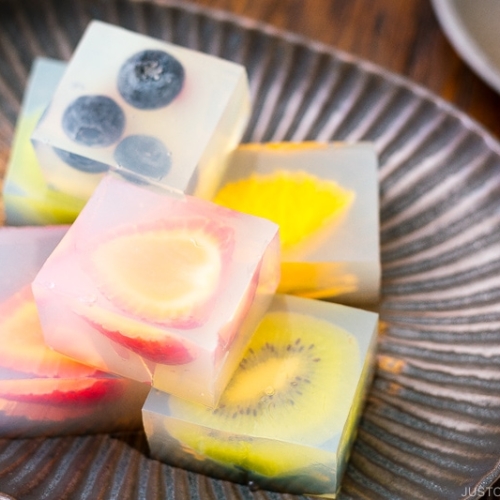
Fruit Jelly
Ingredients
- 2 cups water
- 4 g kanten (agar) powder (1 package, 2 tsp)
- ¼ cup sugar (4 Tbsp for “healthy“ and 6–8 Tbsp for “dessert;“ please read the post)
- fruits of your choice (oranges, strawberries, blueberries, and kiwi work well)
Instructions
- Gather all the ingredients. You will need a nagashikan (6 x 5.1 x 1.8 inches, 15 x 13 x 4.5 cm) or a similar-sized container lined with plastic wrap.

- In a small saucepan, add 2 cups water and 4 g kanten (agar) powder. Whisk to combine and bring it to a boil.

- Once boiling, lower the heat and cook for 2 minutes. Whisk occasionally and make sure the kanten powder has completely dissolved. After 2 minutes, remove from the heat.

- Add ¼ cup sugar and whisk until sugar is completely dissolved.

- Run water in the mold (or nagashikan) and pour the liquid until there is about ⅓ inch (8 mm) in the mold (so that the fruit won‘t touch the bottom). Using a spoon or toothpick, move the bubbles on the liquid to the corner and remove them. Let cool in the refrigerator for just under 10 minutes or at room temperature for a little longer time.

- Meanwhile, cut the fruits of your choice for the jelly.

- The thickness of the fruit should be about the same.

- When the bottom layer is slightly set (neither liquid nor completely set), place the fruits on top. If the bottom layer set too firm, the top layer will not attach to the bottom layer well and the fruit jelly will separate into the top and bottom layers when you cut. The liquid in the saucepan should not be solidified since the saucepan is still warm and it has more liquid in there. If solidified, then reheat until it turns to liquid.

- Then, pour the rest of the mixture in the mold. Pop and remove the bubbles. Keep in the fridge until the jelly has set completely.

To Serve
- Run a knife around the mold and gently flip and unmold the jelly. If you’re using the nagashikan, run a knife around the mold and pull up the handles.

- Cut the jelly around the fruit so they look prettier. Serve chilled on a plate.

To Store
- You can keep the jelly in an airtight container and store in the refrigerator for up to 2 days.





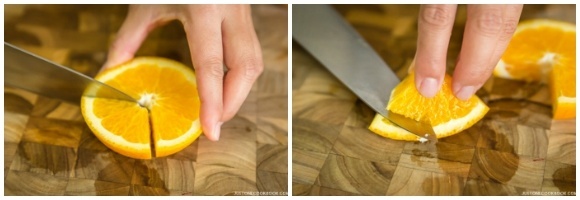




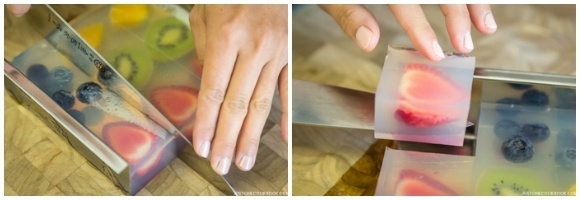











This was easy to make but my fruit (raspberries, blackberries and mandarine oranges) floated to the top when I put my 2nd layer of kanten on top. How do I keep the fruit from floating to the top?
Hi, Cissy! Thank you very much for trying Nami’s recipe!
When the jelly begins to solidify, you may push it with a toothpick.
Alternatively, you may make it a thinner jelly. 🙂
Hi! How long can the jelly keep in the fridge
Till it loses its freshness?
Hi Ida! Thank you for trying Nami’s recipe!
You can keep the jelly in an airtight container and store it in the refrigerator for up to 2 days.🙂
We hope this helps!
Hello, how can I fix it if I waited too long and the bottom layer is set already? Delicious recipe, by the way!
Hi Mia, Thank you very much for trying this recipe! You can fix it! Transfer the Jelly into the pot and reheat over low heat for 2~3 minutes. The jelly will be soft again. We hope this helps!
Hi Naomi, I’m so happy to discover this recipe! Yesterday, I bought a serving of white peach jelly (with the beautiful peach inside) from the dessert counter at Mitsuwa. It was so good but so pricey ($24 = total splurge). I have a question, though. I want to flavor my homemade batch with fruit juice but how much should I add? Then, how much sugar? I don’t like things that are too sweet. Thanks much.
Hi Trey!
$24 jelly!? We are sure it was delicious.😄
If you plan to add the fruit juice to your Jelly and like less sugar, how about no sugar and add 1/4 cup of fruit juice to the water to see if you like the sweetness? Please make sure that the total liquid amount should be 2 cups. (1/4 cup juice + 1-3/4 cups of water etc.)
Nami also has an Orange Jelly recipe that uses fruit juice with gelatin sheets. You may want to check it out too.
https://www.justonecookbook.com/orange-jelly/
We hope this helps!
Hi,
Thank you for sharing!
This looks so good and easy, just wondering, does agar needs refrigeration once is set?
Hi Raf,
We recommend refrigeration. This Agar fruit jelly is best to serve in cold.
I hope this is helpful.🙂
Can this recipe be canned in a mason jar? If so, what is the recipe for that?
Hi Miki! Are you going to use a 4 oz (or smaller) jar for an individual serving? Then sure, you can do that. Instead of cutting into pieces, you can scoop and eat. You have to divide the mixture tho. I’ve never tried it, so you may test and see how many you need and how much mixture each jar requires.
I’m using 6 oz jars and hoping that the canning process will make the ゼリー shelf safe (not require refrigeration). Do you think that would be possible?
Hi Miki! Hmm what kind of canning process will you be doing to “preserve” at room temperature? I’m not sure if you can do that for fresh fruits…
Would you recommend doubling the recipe to make it in an 8×8 pan?
Hi Akiko! Yes, so that the fruit is covered properly and solidify. 🙂